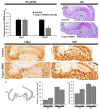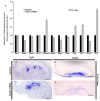Developmental Roles of FUSE Binding Protein 1 (Fubp1) in Tooth Morphogenesis
- PMID: 33138041
- PMCID: PMC7663687
- DOI: 10.3390/ijms21218079
Developmental Roles of FUSE Binding Protein 1 (Fubp1) in Tooth Morphogenesis
Abstract
FUSE binding protein 1 (Fubp1), a regulator of the c-Myc transcription factor and a DNA/RNA-binding protein, plays important roles in the regulation of gene transcription and cellular physiology. In this study, to reveal the precise developmental function of Fubp1, we examined the detailed expression pattern and developmental function of Fubp1 during tooth morphogenesis by RT-qPCR, in situ hybridization, and knock-down study using in vitro organ cultivation methods. In embryogenesis, Fubp1 is obviously expressed in the enamel organ and condensed mesenchyme, known to be important for proper tooth formation. Knocking down Fubp1 at E14 for two days, showed the altered expression patterns of tooth development related signalling molecules, including Bmps and Fgf4. In addition, transient knock-down of Fubp1 at E14 revealed changes in the localization patterns of c-Myc and cell proliferation in epithelium and mesenchyme, related with altered tooth morphogenesis. These results also showed the decreased amelogenin and dentin sialophosphoprotein expressions and disrupted enamel rod and interrod formation in one- and three-week renal transplanted teeth respectively. Thus, our results suggested that Fubp1 plays a modulating role during dentinogenesis and amelogenesis by regulating the expression pattern of signalling molecules to achieve the proper structural formation of hard tissue matrices and crown morphogenesis in mice molar development.
Keywords: Fubp1; amelogenesis; dentinogenesis; tooth development; transcriptional regulator.
Conflict of interest statement
The authors declare no potential conflicts of interest with respect to the authorship and/or publication of this article.
Figures





References
-
- Gilbert S.F., Barresi M.J.F. Developmental Biology, 11th Edition 2016. Am. J. Med. Genet. Part A. 2017;173:1430. doi: 10.1002/ajmg.a.38166. - DOI
MeSH terms
Substances
Grants and funding
LinkOut - more resources
Full Text Sources
Research Materials

